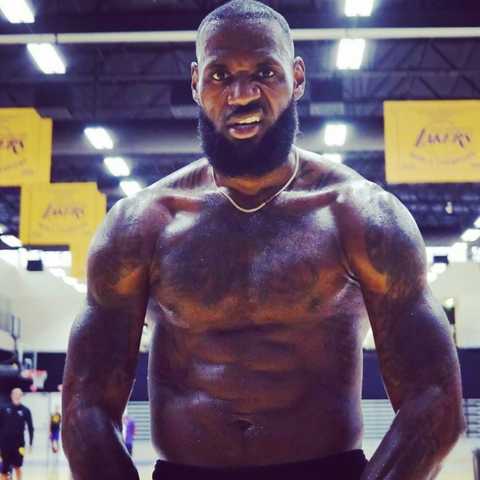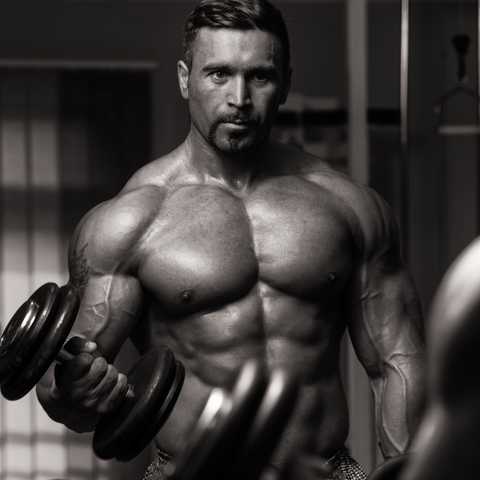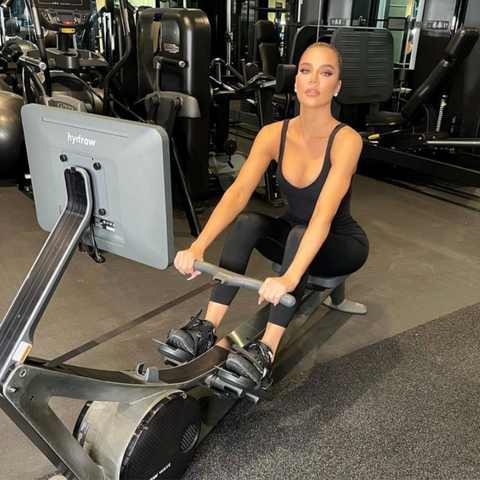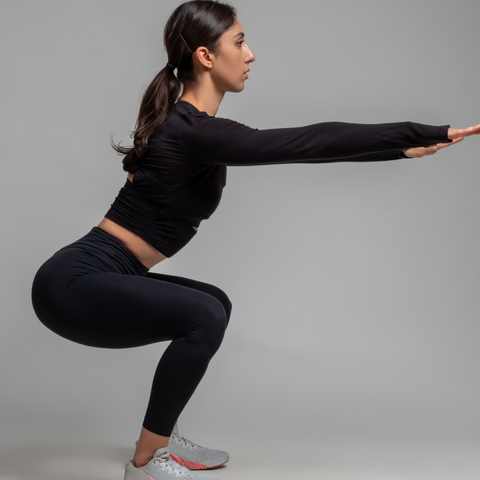But, has anyone ever asked you how much you can decline bench?
We’re going to go out on a limb here, and guess that it’s highly unlikely someone has asked you about your ability to decline press.
There’s no denying it’s a less common exercise, yet it is still a fantastic move for your chest routine, particularly for those trying to target the lower chest muscles.
And if you’re not already performing the decline press? You’re in luck as this article is about to go over in detail how to perform and use the decline bench press in your routine.
Table of Contents:
- What Is The Decline Bench Press?
- Decline Bench Press vs Flat vs Incline: What Are The Differences?
- Decline Bench Press Muscles Worked
- Decline Bench Press Form
- Form Tips And Common Mistakes To Avoid
- Decline Bench Press Benefits
- Decline Bench Press Drawbacks
- Decline Bench Press Variations And Alternatives
- How To Program The Decline Bench Press
- Sample Chest Workout Program
- Does Your Routine Need The Decline Bench Press?

What is The Decline Bench Press?
There are three variations of the bench press that use different bench angles, which includes incline, flat, and decline. The decline bench press falls under the horizontal press umbrella. A horizontal pressing exercise is typically done while lying on a bench.
The decline bench press angle should be between 15 and 30 degrees. The decline press will target and activate the fibers of the lower chest muscles much more than the other variations1. It’s important to note that the rest of the chest still works during the decline press, but it hits the lower chest more effectively than the traditional and incline versions.
We will touch more on the benefits and drawbacks, but to understand the bench press better, let’s first compare the three variations.
Decline vs Incline vs Flat Bench Press: What are the differences?
The decline, incline, and flat bench press are all compound exercises that fall under the horizontal pressing category. Horizontal pressing means pushing away from your chest as opposed to a vertical press that presses up overhead, such as in the overhead press.
This pressing motion is king for developing the front half of your upper body. Horizontal presses build the pectoral muscles, deltoids, and triceps.
All three variations have a place in your program and figuring out where to put them comes down to understanding your goals, imbalances or lagging body parts, and what works best for your body.
Flat bench press:
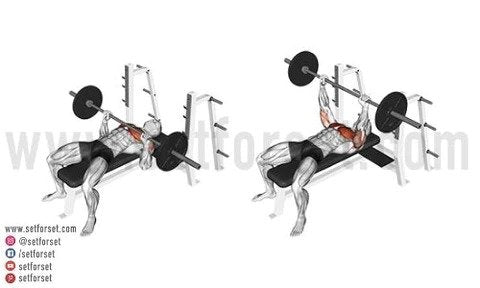
Flat bench presses are the most common pressing variation, typically performed using a flat bench and a barbell or dumbbell.
The traditional bench press, and even the floor press, are well-rounded enough that they do a pretty good job hitting all of the pectoral muscles. It will help you get the most complete chest development out of the three presses.
Incline Bench Press:
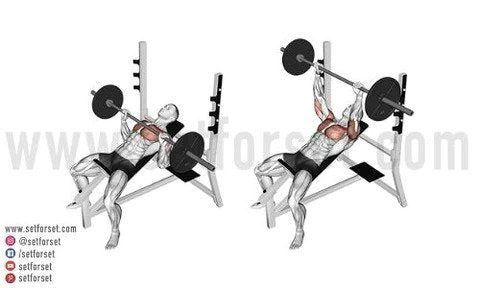
The incline press is the same type of pressing motion, but it is done with the bench at an incline angle of around 30 degrees.
This press focuses more on targeting the upper pecs and doesn’t activate the middle and lower chest as much. It is the best exercise for building muscle in the upper pec fibers.
Decline bench press:

The decline bench press is probably the least common, but it has profound benefits. This variation targets the lower pectoral muscles the best and can be much safer for your shoulders.
You’ll perform the same pressing movements as with the flat and incline versions, but the bench is set at a decline between 15 and 30 degrees. The decline bench press can feel more awkward than the other two variations, so start with a light weight while you get used to your body’s positioning.
What Muscles Does The Decline Bench Press Work?
Here’s a closer look at the decline bench press target muscles.
Pectoralis major & minor:
The pec major is the biggest muscle of your chest and has two heads. The clavicular head, commonly known as the upper chest, originates from the clavicle. The sternocostal head, known as the middle and lower chest, originates from the sternum. They both insert onto the humerus and function during chest and shoulder movements.
The decline bench press primarily targets the sternocostal head. In addition, the pec minor, which lies underneath the pec major and is located on the front of the ribcage, is also activated.
Triceps:
The horseshoe muscle on the back of your upper arm has three heads: medial, lateral, and long head. The triceps work to straighten the arm at the elbow joint and stabilize the shoulder. They are mainly active during the lockout portion of the bench press.
Anterior deltoid:
The front portion of your shoulder muscle assists the chest with horizontally adducting the shoulder and shoulder flexion. It is most active during the lowering portion of the decline bench press.
Biceps:
The biceps is a two-headed muscle on the front of your upper arm. The biceps are not as active during the incline or flat bench press variations as they are in the decline version. During the decline, they work synergistically with the triceps during the lowering portion of the exercise.
Latissimus dorsi:
This wing-shaped back muscle is typically activated during pulling exercises. However, the lats work synergistically during the lowering portion of a bench press as the pecs are loaded. It also works at the bottom part of the bench press as they assist with the internal rotation of the arm.
How to Perform The Decline Barbell Bench Press
There are several different variations of decline bench presses that you can perform. Each one may work better for someone based on their training experience, anatomy, and personal preferences.
We will discuss other variations of the decline press later on, but for this how-to, we are focusing on the barbell decline bench press. If you don’t have a decline bench press already set up in the gym, you can also use a decline sit-up bench or place some plates under a flat bar (just make sure it’s secure).
How to Decline Bench Press:
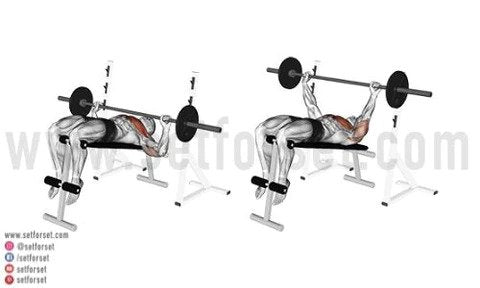
- Set up your decline bench to a 15 to 30 degree angle.
- Lay flat on the bench, making sure your legs and feet are comfortably supported by the bench and hooked into place to maintain your position
- Your decline bench should be attached to a rack with a barbell. If it isn’t, wheel the bench over to a rack to set it up.
- Reach up and grab the bar slightly wider than shoulder-width apart.
- Slowly unrack the barbell. For your starting position, straighten your arms and center the barbell above your chest.
- Slowly lower the bar toward your chest as if you were pulling it and not letting it free fall. Lower the bar until it touches your chest just below the nipple line.
- Press the barbell up by straightening your arms above your body, squeezing your lower chest as if you were pushing your pecs together.
- Repeat for the indicated reps and sets.
Form Tips and Common Mistakes to Avoid
Make sure you’re following best form practices by avoiding these 4 common mistakes.
1. Bouncing the bar off your chest:
The decline bench allows you to use more weight than a barbell bench press. It also can be more awkward to control the bar path as you lower it.
Often you will see lifters bouncing the bar off their chest as a springboard to create momentum before pushing it back up. Not only is this dangerous for your chest (and can be painful), but you’re also leaving gains on the table when you aren’t keeping the tension on the muscle.
Instead of bouncing the bar off your chest, imagine you are gently setting the bar on your shirt. This will stop you from bouncing off your chest or resting it and losing tension.
2. Shortening Your range of motion:
The decline bench changes your bench angle but does not change the movement. You should still be lowering down, trying to gently touch the bar to your chest.
Using the full range of motion will activate your chest fibers to the highest degree and ensure you don’t get injured.
3. Going too heavy:
Due to its setup, the decline allows you to use more weight than a normal bench press.
This can be a fantastic benefit that will enable you to get a greater training stimulus, but you need to be prepared to handle the load under control. Back off and go a little lighter until you feel confident controlling the exercise. Don’t use too much weight to quickly.
4. Sloppily unracking the weight:
Due to the different bench angles and the effect of gravity, unracking the bar can be difficult, especially if you are brand new to the exercise.
Make sure your shoulders are packed into the bench as you lift the weight off the rack. Slowly center the weight over your chest to keep a safe and proper path for the bar.
Decline Bench Press Benefits
Here are 4 great reasons to start incorporating the decline bench press into your workout split.
1. Increases activation of the lower pecs:
The lower chest makes up the biggest portion of the chest but can be harder for most people to grow.
The pecs are active during each bench press variation, but the decline activates the lower portion the best. This helps even out the chest muscles and the appearance of the upper body.
2. Allows for a heavier load:
We mentioned it could be potentially dangerous if you are new to the exercise, but if you’re able to increase your load safely, loading more weight with this variation is a serious benefit.
Emphasizing progressive overload and using more weight is only going to increase the growth of your pec muscles.
3. It’s more shoulder-friendly:
It’s important to note that all bench presses can be tough on the shoulders. Your anatomy will determine just how tough.
However, the decline ends up being more shoulder-friendly due to the angle of the bench. It also distributes more load onto the lower chest, so the shoulders are not as taxed during the movement.
4. Places less stress on your lower back:
You’ve likely seen plenty of arched bench press videos circulating on social media. If you are a competitive powerlifter, sure, the arch will help with leg drive and shortening your range of motion in a competition.
But if you are a general gym goer, you want less arch in your back and more tension on your chest. The decline bench removes the arch as your legs are locked into position to stay on the bench. This allows greater activation of the lower chest and less worry about injuring your lower back.
This results in muscle hypertrophy while reducing your risk of injury with other body parts.
Decline Bench Press Drawbacks
No matter how awesome an exercise is, nothing is perfect! Here’s a look at the key decline bench press drawbacks.
- The angle of the bench can be awkward to get used to and complex to get in and out of.
- The pressing motion can be uncomfortable due to the different angles and force of gravity during the movement.
- It primarily targets one part of the chest. There may be better options, like the traditional bench press, if your goal is full chest development.
- It can be challenging to perform without a spotter.
3 Decline Barbell Bench Press Variations
The barbell is great, but these variations are too! Here are 3 ways to use different equipment to perform the decline bench press.
1. Decline dumbbell bench press:
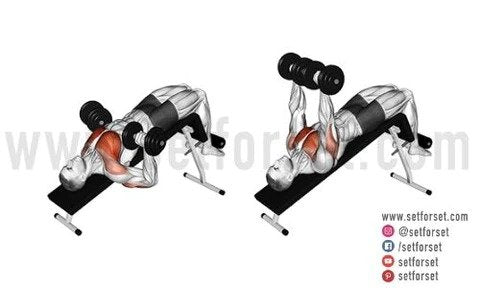
Using the same movement as the barbell decline press, you’ll use dumbbells in place of the barbell while in a decline position. It’s important to note that dumbbells can be more challenging to set up.
You will either need to pick them up off the floor once you are set up on the bench or have someone hand them to you. A benefit of using dumbbells is you can turn the dumbbell decline press into a unilateral exercise, further allowing you to even out chest muscle imbalances by working one side at a time.
2. Cable decline bench press:
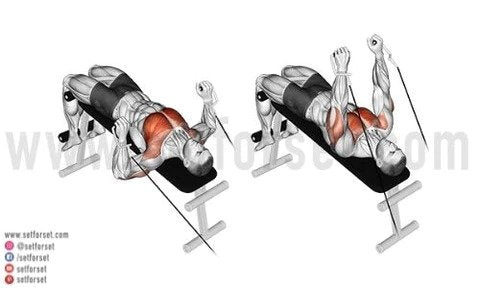
Similar to the dumbbell decline bench press exercise, the cable decline press is a decline bench press alternative that can also be challenging to set up. You will need to wheel a decline bench over to the cable area.
Set the cables up at the lowest setting. If you can grab them yourself, great, but otherwise you may need someone to hand you the cables. Use an overhand grip when performing this exercise.
The cables will help keep tension on the muscles throughout the entire movement and will enable you to feel the stubborn lower chest working.
3. Kettlebell decline bench press:
The setup is the same as using dumbbells, but the weight distribution on the kettlebell will make this exercise feel much different. Try using a neutral grip and work on keeping your forearms vertical throughout the movement.
You will feel the chest working as if performing a bench press while resisting a chest fly. The biceps will also be fired up more than normal during this movement.
Kettlebell Decline Bench Press Demo on YouTube
3 Decline Bench Press Alternatives
Looking for more good options to work your lower chest? Here are three alternatives to consider including in your next chest and triceps workout (or any chest workout, for that matter!).
1. Incline push-up:
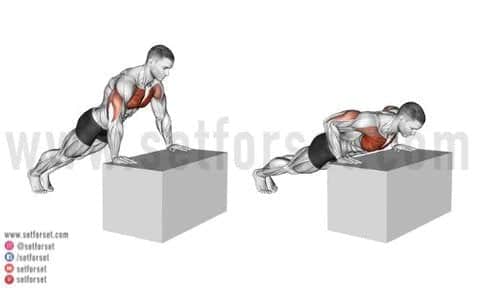
Oh, how we love push up variations! And this one is a great bodyweight option that will benefit the lower chest similarly to the decline bench press. Instead of having your body parallel to the floor like a normal push-up, you will place your hands on a bench or box to elevate your body angle.
Lower yourself down as close to the bench as you can and press the bench away, squeezing the pecs together in the same fashion you would when performing the decline bench.
2. High to Low Cable Crossover:
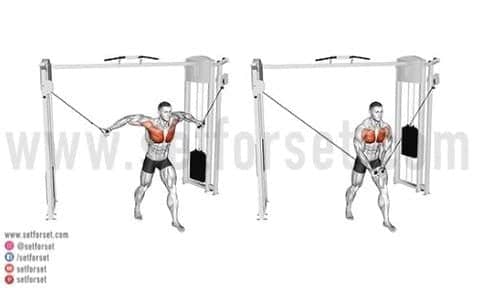
This alternative is not a pressing variation like the other exercises but is still fantastic for targeting the lower chest and sternocostal head.
To begin, set the cables up at a relatively high setting and face away from the stack. With your elbows slightly bent, squeeze your pecs, bringing the cables down and across your body toward your waistline.
Slowly raise them back to the starting position as you feel the chest stretch out.
If you don’t have a cable machine or it’s always busy at your gym, there are alternatives to the cable crossover.
3. Vertical dips:
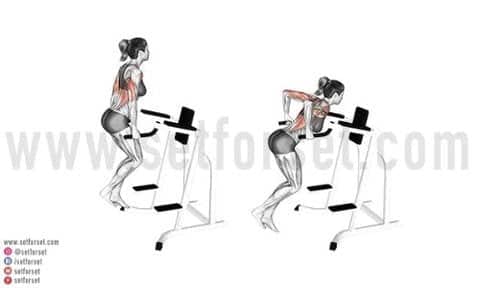
It’s important to note that two different dip variations look similar but emphasize different muscles. Vertical dips target the lower chest more, and horizontal dips target the triceps more. Set up on your dip station with one bar in each hand.
Put all the weight in your hands and lift your feet off the floor while leaning forward some. Bend your elbows and lower yourself until your arms reach a 90-degree angle.
Exhale and push your hands into the bars to straighten your arms and return to the starting position.
How to Program The Decline Bench Press
When programming the decline bench press, it’s important to remember what your goals are.
Are you looking to build your lower chest, upper chest, or full chest, increase muscular strength for bench pressing, or improve your muscular endurance? Whatever your goals may be, here are some guidelines for the decline bench.
- For Strength: Try 3-4 sets of 4-6 reps, resting 2-3 minutes between sets.
- For Hypertrophy: Try 4-6 sets of 8-12 reps, resting no more than 90 seconds between sets.
- For Endurance: Try 2-3 sets of 15+ reps, resting no more than 90 seconds between sets.
Sample Chest Workout Program
This sample workout is perfect for anyone looking to increase the size and strength of their chest. The order of exercises and variations is essential and ensures that each exercise achieves its purpose, so follow it exactly.
For the superset, perform incline push-ups, followed immediately by band pull-aparts. Rest, and then repeat the superset again.
|
Exercise |
Sets |
Reps |
|
Superset: |
2 |
15 |
|
Barbell Bench Press |
3 |
6 |
|
Incline DB Bench Press |
3 |
8 |
|
Decline DB Bench Press |
3 |
10 |
|
Cable Crossovers |
2 |
15 |
|
Vertical Dips |
2 |
To failure |
|
Chest Press Machine |
2 |
20 |
Does Your Routine Need The Decline Bench Press?
Most people don’t absolutely need the decline bench press. It’s crucial to remember that just because it does the best job of targeting the lower chest does not mean those muscles are not working during the other variations.
Whether the decline bench press is essential to your routine will depend on your genetics, body type, and preferences while training. Your takeaway should be that you need to find a pressing variation that works for you and fits your goals. If you have a stubborn lower chest, add this to your program.
The decline bench press is not as common and is often neglected, but its awesome benefits shouldn’t be ignored. Check your ego, lower the weight to start, and practice the lift until you feel confident. Then, you’ll be seeing lower chest gains in no time!
Looking for more moves to hit your lower chest? Check out our article on the 7 Best Lower Chest Exercises!

